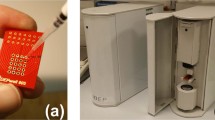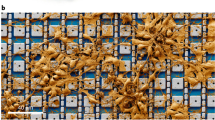Abstract
ONE of the most important artefacts in electrophysiology is the microelectrode tip potential1,2. Its existence precludes accurate determination of cell membrane resting potentials, particularly with extracellular solutions of low ionic strength where the error may be as large as 50 mV. Adrian1 found that the tip potential of electrodes filled with 3 M potassium chloride was logarithmically related to the external concentration of sodium chloride or potassium chloride (in an inverse way) and correlated with electrode resistance (correlation coefficient ≈ 0.7). It was concluded that tip potentials are junction potentials produced by some substance blocking the tip of the electrode, reducing the mobility of the chloride ion and exaggerating the difference of mobility of the sodium and potassium ions. This communication is primarily concerned with a simple method for eliminating tip potentials and with an extensive series of observations on the tip potential phenomenon.
This is a preview of subscription content, access via your institution
Access options
Subscribe to this journal
Receive 51 print issues and online access
$199.00 per year
only $3.90 per issue
Buy this article
- Purchase on Springer Link
- Instant access to full article PDF
Prices may be subject to local taxes which are calculated during checkout
Similar content being viewed by others
References
Adrian, R. H., J. Physiol. (Lond.), 133, 631 (1956).
Frank, K., and Becker, M. C., in Physical Techniques in Biological Research, edit. by Nastuk, W. L., 5A, 23 (Academic Press, New York, 1964).
Bates, R. G., in Reference Electrodes, edit. by Ives, D. J. G., and Janz, G. J., 250 (Academic Press, New York, 1961).
Hubbard, D., J. Res. Nat. Bur. Standards, 36, 511 (1946).
Davies, J. T., and Rideal, E. K., Interfacial Phenomena, 118, 131, 148 (Academic Press, New York, 1963).
Bates, R. G., Determination of pH, 310 (Wiley, New York, 1964).
Dole, M., The Glass Electrode, 70 (Wiley, New York, 1941).
Author information
Authors and Affiliations
Rights and permissions
About this article
Cite this article
AGIN, D., HOLTZMAN, D. Glass Microelectrodes: the Origin and Elimination of Tip Potentials. Nature 211, 1194–1195 (1966). https://doi.org/10.1038/2111194a0
Issue Date:
DOI: https://doi.org/10.1038/2111194a0
This article is cited by
-
Intracellular gradients of electrical potential in the epithelial cells of theNecturus gallbladder
The Journal of Membrane Biology (1977)
-
pH-sensitive glass microelectrodes and intracellular pH measurements
Biophysics of Structure and Mechanism (1976)
-
Studies on the origin of the tip potential of glass microelectrode
Biophysics of Structure and Mechanism (1976)
-
A holder for rapid filling of micropipette electrodes by centrifugal action
Pflügers Archiv (1974)
Comments
By submitting a comment you agree to abide by our Terms and Community Guidelines. If you find something abusive or that does not comply with our terms or guidelines please flag it as inappropriate.



